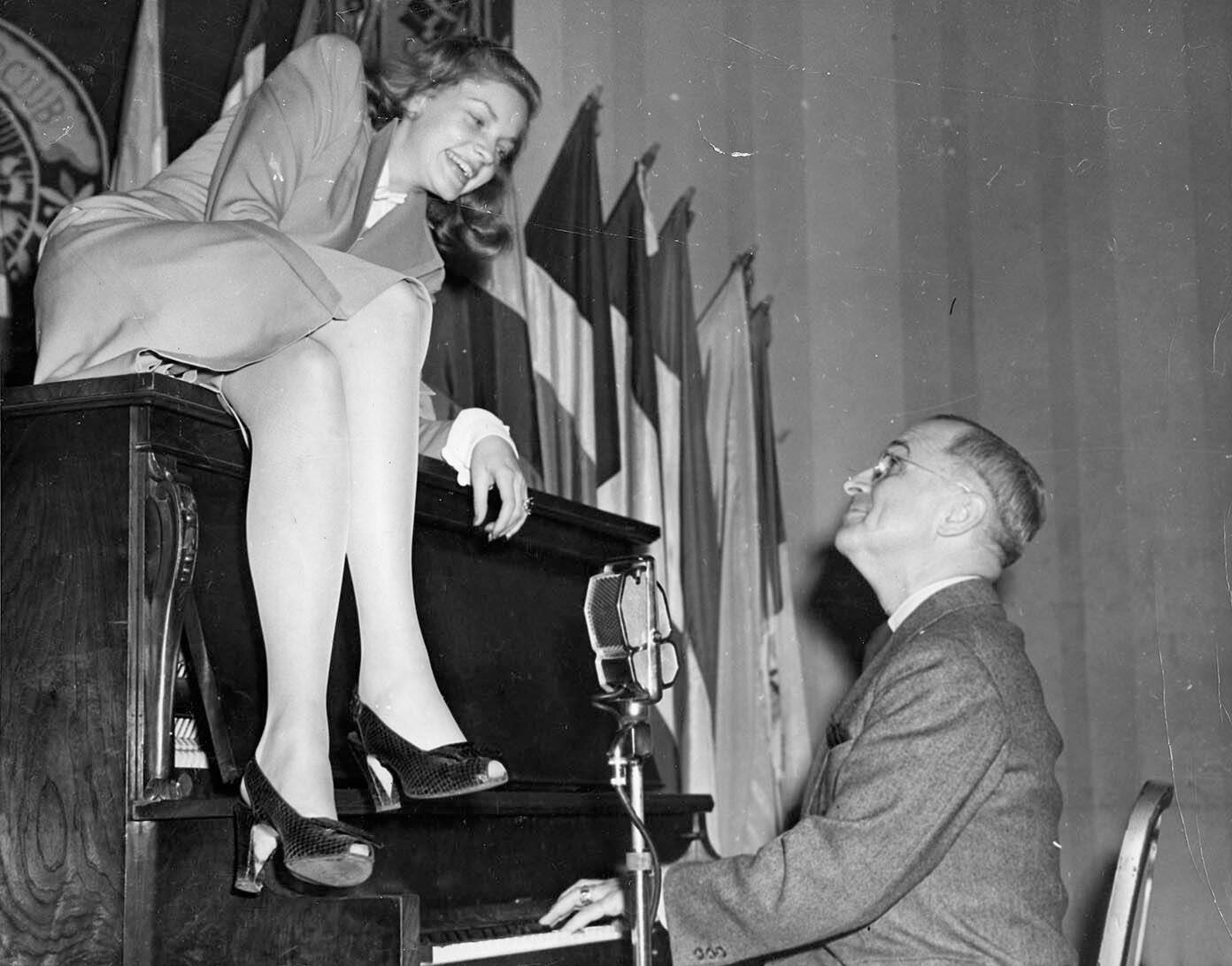Authors:
Historic Era: Era 8: The Great Depression and World War II (1929-1945)
Historic Theme:
Subject:
November/December 2021 | Volume 66, Issue 7


Authors:
Historic Era: Era 8: The Great Depression and World War II (1929-1945)
Historic Theme:
Subject:
November/December 2021 | Volume 66, Issue 7
Editor's Note: Veteran reporter and journalism professor Gil Klein is author of Tales from the National Press Club and a former president of the Club.

Of the many thousands of photos taken at the National Press Club over the years, one stands out for its enduring appeal. Taken on a Saturday night, February 10, 1945, it shows actress Lauren Bacall, then just 20 years old but already a huge Hollywood star, sitting atop an upright piano with her shapely legs hanging over the front as she looks down on Harry Truman. He looks up at her while playing.
Truman later admitted the incident “caused me a hell of a lot of trouble at home.” The story of how the incident came to happen began two a half years earlier as World War II was getting into in full swing. In November, 1942 the chaplain of the H.M.S. Essex, then being refitted at the Norfolk Navy Yard, called the Press Club and mentioned he had 80 sailors wanting to come to Washington for sightseeing. Where should they go for entertainment?
A few Club members got together and arranged for the sailors to come over and drink all the beer they could hold.
Not surprisingly, free beer was quite a hit with sailors and for the rest of the war the Club made it a weekly affair sponsored by its own American Legion Post, which had been formed in 1919 by General John J. Pershing and other World War I veterans.
Dubbed the National Press Club Canteen, every Saturday the ballroom was open to any American or Allied serviceman who wanted to stop by. It soon became a principal port of call for every soldier or sailor on weekend leave in the Nation's Capital. Up to 700 would show up each week.
Only enlisted men were invited. No brass need apply. But the Club thought the servicemen should meet representatives of the nation that was sending them around the world to fight. Senators, representatives, Cabinet members, and even eight out of nine members of the Supreme Court showed up. Some of the men found it amusing to be eating frankfurters with Justice Felix Frankfurter. The politicians could make informal remarks, but were blessedly limited to two minutes.
Photo by Larry Feinberg." data-entity-type="file" data-entity-uuid="c65464cc-758e-44b3-b3e0-102aae580b9c" height="432" src="https://www.americanheritage.com/sites/default/files/inline-images/John%20Tepper%20Marlin%20at%20the%20piano.png" width="339" loading="lazy">
Military bands showed up – the Marine Band, the Army Band, the Air Corps Band, the Coast Guard Band. Bands from local military bases appeared. They played boogie-woogie. Entertainers showed up for impromptu performances, including the entire chorus of Earl Carrol’s Follies.
And that brings us to February 10, 1945.
Lauren Bacall’s big breakthrough hit,To Have and To Have Not, had just been released. She and Humphrey Bogart had begun an affair that was capturing some headlines. As part of the movie’s publicity, Warner Bros. studio wanted her to appear at the Press Club canteen. At first, she balked, saying she wanted to be with Bogie, but after a personal appeal from Jack Warner, she relented. Her press agent, Charles Einfeld, came with her.
At the same time, Truman, still relatively unknown after Roosevelt plucked him out of the Senate to be his running mate, was living in an apartment on Connecticut Avenue. He had been Vice President for three weeks. He told his wife, Bess, that he was going to the Press Club to entertain the troops. After all, he was an accomplished piano player. It was an all-men’s Club. How could he get in any trouble?
In her memoir, By Myself and Then Some, Bacall remembered the day this way:
Truman may not have been wild about the photo, but Bess was livid. She found it demeaning of a man of Truman’s stature, and didn’t let him forget it. Fifteen years later, when Truman made a post-presidential visit to the Club, he said how wonderful it was to be back at the Club, even though “some smart press fellow” had “caused me a hell of a lot of trouble at home.”